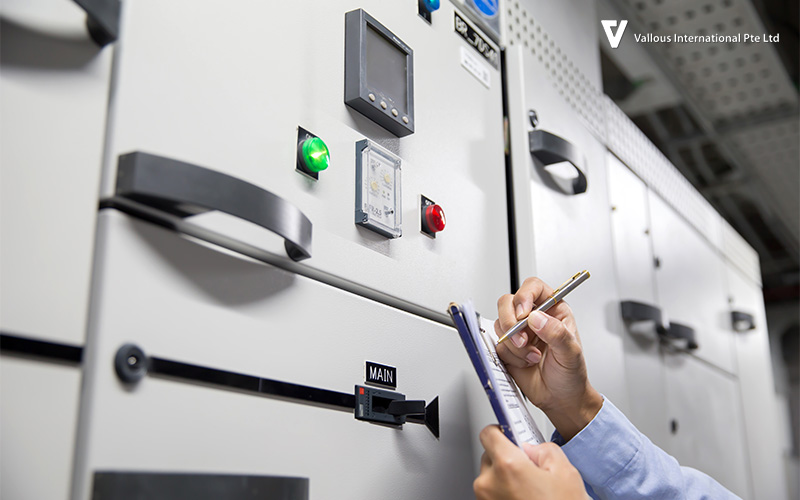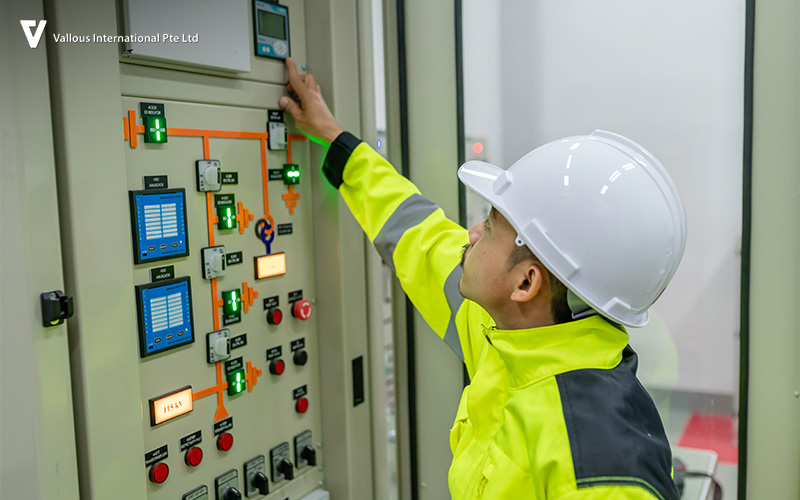
Key Takeaways:
How are Single-Phase and Three-Phase Power Systems Different From Each Other?
- Single-phase power is suited for low-demand applications, while three-phase power handles higher loads more efficiently and reliably.
- Three-phase systems offer better performance, especially in industrial settings. They’re costlier to install but provide long-term savings and scalability.
- Choosing the right system depends on your power needs and future growth plans.
Why Work with Vallous International?
At Vallous International, we offer tailored power solutions that include:
- Single-phase and three-phase systems
- UPS maintenance services
- 24/7 onsite support
Introduction
Choosing the right electrical power configuration is a crucial step in planning any commercial or industrial infrastructure. For facility managers and procurement teams, deciding between single-phase and three-phase power goes beyond immediate installation costs, potentially impacting system performance and long-term operational reliability. An unsuitable setup can lead to voltage fluctuations, inefficient power delivery, or even costly equipment damage. Therefore, it is essential to understand the differences between these two configurations to ensure stable energy usage and maximise cost-effectiveness. This article will walk you through the key distinctions to help you make an informed and future-ready decision.
How are Single-Phase and Three-Phase Power Systems Different From Each Other?
1. Power Delivery
At its core, the difference starts with how electricity flows. Single-phase power delivers electricity via a single alternating current waveform. It’s commonly used in low-demand settings like homes, small offices, and light commercial equipment.
Three-phase power, on the other hand, supplies electricity through three synchronised waveforms, providing a more stable and consistent energy flow. This configuration is vital for high-demand systems, such as manufacturing equipment, HVACs, and industrial-grade machinery. When a power supply for industrial applications is on the line, three-phase systems are the preferred choice.
2. Electrical Load Handling Efficiency
When comparing single-phase and three-phase power, load handling efficiency is another key consideration. Load handling efficiency means how effectively an electrical system can manage and distribute power to connected devices or equipment without interruptions. In simple terms, it’s about how well a power system can handle the electrical demand placed on it.
Single-phase power may be adequate for smaller setups, such as homes or light commercial environments. However, it often struggles with high-demand equipment due to its uneven power flow. This can result in voltage drops and reduced performance, particularly over long distances or with multiple connected devices.
In contrast, three-phase power excels at electrical load handling efficiency. It is designed to handle heavier electrical loads with greater efficiency. Its smooth and continuous power delivery ensures balanced energy distribution across all connected systems. This not only enhances electrical load handling efficiency but also reduces stress on equipment.
3. Application
Different environments have vastly different power requirements. That’s why choosing between single-phase and three-phase power depends heavily on the specific application. Single-phase systems are most commonly used in settings with relatively low power demands. These include residential buildings and retail outlets, where the electrical load is limited to lighting, fans, computers, and light-duty appliances. The infrastructure is simpler, more affordable, and easier to maintain.

Meanwhile, three-phase UPS systems serve as the backbone of high-demand environments. Industrial facilities, manufacturing plants, commercial complexes, hospitals, and data centres often rely on three-phase power to support heavy-duty machinery and other mission-critical equipment. This configuration allows for consistent voltage delivery, enhancing power stability and electrical load handling efficiency.
For example, organisations seeking a single-phase UPS in Singapore for smaller IT loads or emergency lighting can benefit from a simpler infrastructure and quicker installation. In contrast, a three-phase option supports larger critical infrastructure with better power stability and load balancing.
4. Cost and Installation Considerations
When it comes to the cost of electrical system installation, the differences between single-phase and three-phase power are not just about initial setup costs. Businesses must also consider long-term operational value, scalability, and maintenance requirements.
Generally, single-phase installations are simpler and more affordable to implement. With fewer components and a more straightforward layout, they are well-suited for small-scale operations, startups, or pop-up stores that don’t require a large energy load. The ease of installation also means less downtime during setup, allowing businesses to get up and running quickly. Despite the lower upfront cost, the system may become inadequate as power demands grow. This may lead businesses to face the need for reinvestment or incur costly upgrades down the line.
For three-phase systems, their installation requires more sophisticated infrastructure, including additional wiring, larger circuit breakers, and more robust protective equipment. This translates to higher initial costs and longer installation timelines. But for businesses with high or growing power demands, this investment can be far more cost-effective in the long run. In other words, these systems offer a better load balance and lower energy losses. Over time, this contributes to lower maintenance costs and better return on investment.
Why Work with Vallous International?
The choice between single-phase and three-phase power isn’t just about technical specs. In fact, it’s also about aligning your power infrastructure with your business goals. Looking to boost electrical load handling efficiency or reduce the cost of electrical system installation? Vallous International is ready to help your business power ahead with confidence.
Selecting the right system is only part of the equation. Maintenance and support are just as essential to ensure continuous power availability. At Vallous International, we offer tailored power solutions that include:
UPS Systems
Available in both single-phase and three-phase configurations, matched to your load requirements and site conditions.
UPS Maintenance Services
Choose between half-yearly or yearly plans, depending on the criticality of your systems.
24/7 Onsite Support
Our round-the-clock support ensures uninterrupted power protection and immediate technical intervention.
Contact us, and let our reliable, custom-fit power solutions safeguard your operations.
Vallous International | Content Brief | October 2025
100%
E37
FAQs about Single Phase and Three Phase Power
1. What is the main difference between single phase and three phase power systems?
Single phase power uses one alternating current (AC) waveform, while three phase power uses three waveforms, each offset by 120 degrees. This makes three phase power more stable and efficient for larger loads, such as industrial or commercial facilities. To learn how this affects energy reliability, explore our solutions.
2. How does load-handling efficiency differ in single phase and three phase power setups?
A three phase system can deliver more power using less current, resulting in improved load-handling efficiency and smoother equipment operation. Single phase systems, on the other hand, are better suited for smaller, lower-demand applications. Discover how three phase setups enhance uptime here.
3. What factors affect the cost and installation process of each system?
Installation costs depend on power requirements, cabling complexity, and the scale of the facility. Single phase systems are generally less expensive and simpler to install, while three phase systems offer long-term cost efficiency for high-demand environments. Contact us to find the right solution for your business.
4. What maintenance practices help ensure long-term reliability and performance?
Routine inspections, voltage monitoring, and timely component replacement are key to maintaining stable power performance. Partnering with experienced providers who offer regular system checks and maintenance services helps prevent downtime.
5. What is the difference in voltage capacity between single phase and three phase power?
Single phase systems typically operate at lower voltages (230V–240V), suitable for domestic and small business applications. Three phase systems can deliver higher voltages (400V and above), making them ideal for industrial machinery, data centres, and large-scale infrastructure.
6. Which type of power is more efficient for high-demand and long-distance transmission?
Three phase power is significantly more efficient for transmitting electricity over long distances, reducing line losses and improving overall power quality. It’s the preferred option for high-load facilities requiring consistent voltage levels.